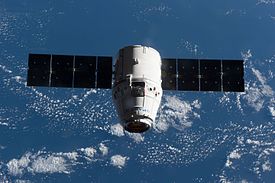SpaceX CRS-10

Dragon approaching the ISS on 23 February 2017
|
|
| Mission type | ISS resupply |
|---|---|
| Operator | SpaceX |
| COSPAR ID | 2017-009A |
| SATCAT no. | 42053 |
| Mission duration | Planned: 28 days Elapsed: 24 days, 23 hours, 44 minutes |
| Spacecraft properties | |
| Spacecraft | Dragon C12 |
| Spacecraft type | Dragon CRS |
| Manufacturer | SpaceX |
| Dry mass | 4,200 kg (9,300 lb) |
| Dimensions | Height: 7.2 m (24 ft) Diameter: 3.7 m (12 ft) |
| Start of mission | |
| Launch date | 19 February 2017, 14:39:00 UTC |
| Rocket | Falcon 9 Full Thrust |
| Launch site | Kennedy LC-39A |
| Contractor | SpaceX |
| Orbital parameters | |
| Reference system | Geocentric |
| Regime | Low Earth |
| Semi-major axis | 6,783.13 km (4,214.84 mi) |
| Eccentricity | 0.000715 |
| Perigee | 400.14 km (248.64 mi) |
| Apogee | 409.85 km (254.67 mi) |
| Inclination | 51.6402° |
| Period | 92.7 minutes |
| Epoch | 2 March 2017, 13:20:36 UTC |
| Berthing at ISS | |
| Berthing port | Harmony nadir |
| RMS capture | 23 February 2017, 10:44 UTC |
| Berthing date | 23 February 2017, 13:12 UTC |
| Unberthing date | Planned: 19 March 2017 |
| Payload | |
| SAGE III and SAGE-NVP, STP-H5, etc. | |
| Mass | 2,490 kg (5,489.5 lb) |
| Pressurised | 1,530 kg (3,373.1 lb) |
| Unpressurised | 960 kg (2,116.4 lb) |
|
|
|
SpaceX CRS-10, also known as SpX-10, is a cargo resupply mission to the International Space Station. The mission was contracted by NASA and was launched by SpaceX aboard a Dragon spacecraft on 19 February 2017. As of 10 March 2017[update], the mission is active with the Dragon spacecraft docked to the ISS, while the Expedition 50 crew has unloaded all material and is reloading the vehicle with experiments and equipment for return to Earth.
CRS-10 is part of the original order of twelve missions awarded to SpaceX under the Commercial Resupply Services contract. As of June 2016[update], a NASA Inspector General report had this mission manifested for November 2016. The launch was put on hold pending investigation of the pad explosion in September 2016, with a tentative date no earlier than January 2017, subsequently set for 18 February.
On 12 February 2017, SpaceX successfully completed a static fire test of the Falcon 9 engines on Pad 39A. An initial launch attempt on 18 February 2017 was scrubbed 13 seconds before its 15:01:32 UTC launch due to a thrust vector control system issue in the rocket's second stage, resulting in a 24-hour hold for launch no earlier than 19 February at 14:39:00 UTC. The faulty actuator was repaired at the launch pad overnight, and the rocket was returned to vertical approximately six hours before the scheduled launch time.
...
Wikipedia

